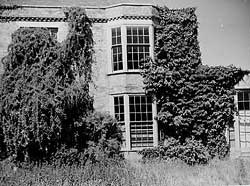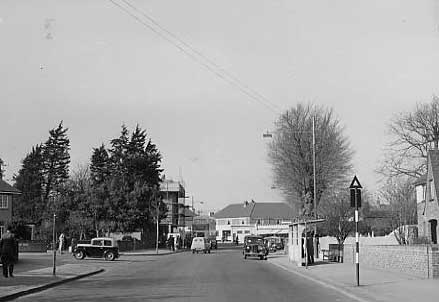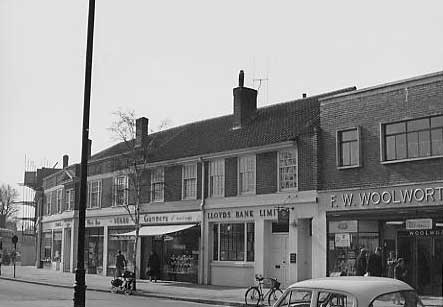|
This article was published in the West Sussex Gazette on January 3rd 2002. 'I am neither a country man nor a son of the soil,' wrote Keith Downer who was born during 1927 at Queen Street in the Parish of Broadwater in a normal terrace house of which the Victorian Age is so renowned. | 
Muir House, Broadwater, photographed by Keith Downer's brother Roy on 5th July 1959 when it had been allowed to run down prior to demolition. Roy's inscription written on the back refers to this view as being of the 'Front main north windows'. | 'My parents were normal, good working-class people. Father was the younger son of a family of eleven, and his father had been a farm labourer at nearby Tich Hill Farm, Sompting. My mother, the second daughter of a local couple, had a plasterer's labourer for a father. Mother's uncles were all connected with the sea: local fishermen, lifeboatmen and sailors. So here we have the beginning, for I shall not dwell on the family ancestors, only to bring out the remarkable coming together of the land and the sea.
Some of my earliest memories include lining up in the school playground of my Junior School for the Silver Jubilee of our King and Queen, George V and Mary, in 1935. So proud as we sang 'Land of Hope and Glory', but even more as the whole school belted out, in our best child-like voices, 'Sussex, Sussex by the Sea'. Now here was something to sing about: 'We Reap and Sow, we Plough and Mow and Useful Men are We', it went on, our voices now ready to make a point out of the last verse 'And when you come to Sussex whoever you may be, you can tell them all, that we stand or fall, for Sussex by the sea'.
All these years afterwards I still get a great thrill from that song, and even in the early 1960's when the Freedom of the Town was given to the Royal Sussex Regiment at the Manor Field and the Regimental Band struck up the March, it was shoulders back and quick march.
Being born in Worthing, of course, we had the choice of seaside of countryside. Apart from a brief courtship with the sea and the making of one or two small boats, which proved to me, once and for all, my interests lay in the countryside. A fact I have not regretted for, although the sea has its mysteries, its rage and anger and also, of course, its beauty, the countryside has always had a lure for me.
As a small boy in the company of my brother Roy we played on the Downs or, as we called it, simply 'up the hills', for that's what they were. Although at times to us they became in turn 'the jungle' alive with animals, or 'the prairie' with vast tribes of savage Indians watching our every movement. We loved them and, within the confines of our playground, the area around the chalk-pit we knew every path and every tree. | 
Broadwater Road looking north, with the Rectory Gardens turn off on the left, photographed by Keith Downer around 1961. The house on the far right of the picture is next to Broadwater Church and has since been taken over by Tribes undertakers. The scaffolding near the centre of the picture marks the construction of the present day Muir House: a shop with offices above.
| Twice, sometimes three times a day, we would go up there. Coils of rope, a young sapling branch cut with our sheath knives became our rifles. 'Watch out for the dreaded Zulu warrior' as we hacked out way through the undergrowth where no white man had trod. Childlike fantasies can conjure up the most real situations especially when one of the bigger boys told us, 'Mind out for bats when you go home as it gets dusk for if a bat gets in our hair you'll have to go to hospital and have all your hair cut off!' My, how we ran down Hillbarn Lane with our jackets pulled over our heads and what a relief when we reached Broadwater Green. Not even walking past the old cemetery could frighten us like the dreaded bats.
Worthing, of course, today is nothing like the town of my childhood. Today, and more is the pity, we have multi-storey car parks, supermarkets, traffic lights and railings, sports pavilions, vast slab-like office blocks forced upon us by some planning committee with, I feel, a grudge against Society. Nothing designed for beauty, only for a functional purpose.
No longer can we stand on our little railway bridge as the old steam train belches through and vast clouds of steam puff up into our eager young faces. No longer can we watch the railway delivery man drive out from the goods yard, sitting up high and pulling on the reins of the magnificent cart-horse, so proud the horse galloped with all polished brasses tinkling. No longer do we hear the bell of the muffin man or see the little fishmonger who called every Sunday with his bicycle loaded with baskets of fresh winkles and shrimps; no longer does the milkman named Scrugggins call with his large churn of fresh milk and wait while you run out with your jug for him to ladle out your pint of creamy milk.
No longer do we smell the fresh bread from the local bake house. 'Got any stale cakes Jack?' we yelled. 'Yes boys, I've got all these trimmings from the chocolate Swiss rolls, any good to you?' No longer do we rush out when Mr Lakes' team of horses comes down the road with huge logs of new timber for Mr. Hartes' timber yard.
No longer, for today is the age of the motorcar, the jet aeroplane, television, the plastic age. Sometimes I feel that plastic people in plastic town halls and plastic government buildings make laws and orders that we may sit in our plastic houses and eat our plastic food.
Because of this, let's get into the countryside where nature beckons us, the air is fresh and man, once again, can attempt to turn the clock back just a little. | 
Broadwater Street West looking south, photographed by Keith Downer about 1961. The scaffolding on the far left of the picture pinpoints the building of the new Muir House.
| This article was published in the West Sussex Gazette on January 3rd 2002.
| |


